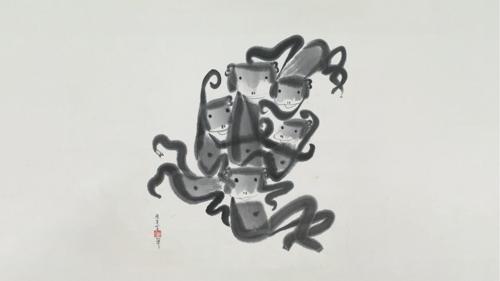陳其寬(1921-2007)以建築師為本業,從事水墨創作逾五十年,在各自領域皆扮演著舉足輕重的領先地位,其建築作品橫跨全球,其中的設計與空間布局思維,皆源自於東方哲學思想與水墨意境的再現,並結合包浩斯主義中所追求的極簡、實用且融合在地元素的精神,形成獨特的時代風格。
文字來源 :臺南市美術館
圖像來源 :陳其寬文教基金會
Chen Chi-Kwan (1921-2007) was a renowned architect by trade but engaged in ink painting for over fifty years. He played a significant role in both fields, achieving leadership status globally. His architectural works, spanning across continents, drew heavily from Eastern philosophical ideas and the aesthetics of ink painting. These influences merged with the minimalist, functional, and locally-integrated spirit of Bauhaus, culminating in a distinctive style that defined his era.
Source: Tainan Art Museum
image: Chen Chi Kwan Education and Culture Foundation

陳其寬的筆記中曾寫下:「太湖石— Henry Moore—童心(猴)—Space—立體派」。太湖石在園林造景中象徵著中國的宇宙觀,其孔洞與石塊形成了虛實相應的意象;而英國藝術家亨利・摩爾的人體雕塑,透過柔軟的四肢與身體相接時所產生的留白空間,恰與太湖石陰陽相生的概念為之契合。陳其寬將這些概念與他對猴群的觀察相結合,融入文人的筆調中,繪製出〈童心〉這件作品。這幅作品富含童趣,且深具東方哲思,透過動畫的轉換展現出萬物生生不息的生命力。
文字來源 :蕭楷競
圖像來源 :陳其寬文教基金會
Chen Chi-Kwan once wrote in his notes: “Taihu Stone—Henry Moore— Youth (Monkey)—Space—Cubism.” Taihu stones, renowned for their role in garden design, embody the Chinese cosmological perspective, where their holes and shapes represent the interplay of solid and void, reflecting the yin and yang principle. Similarly, British artist Henry Moore’s human sculptures, with their fluid limbs and use of negative space, resonate with this idea. Chen Chi-Kwan combines these concepts with his study of monkeys and scholar’s brushwork in Youth. This piece captures both a sense of childlike wonder and profound Eastern philosophy, illustrating life’s vitality through dynamic transformation.
Source: Hsiao kai-Ching
Image: Chen Chi Kwan Education and Culture Foundation
